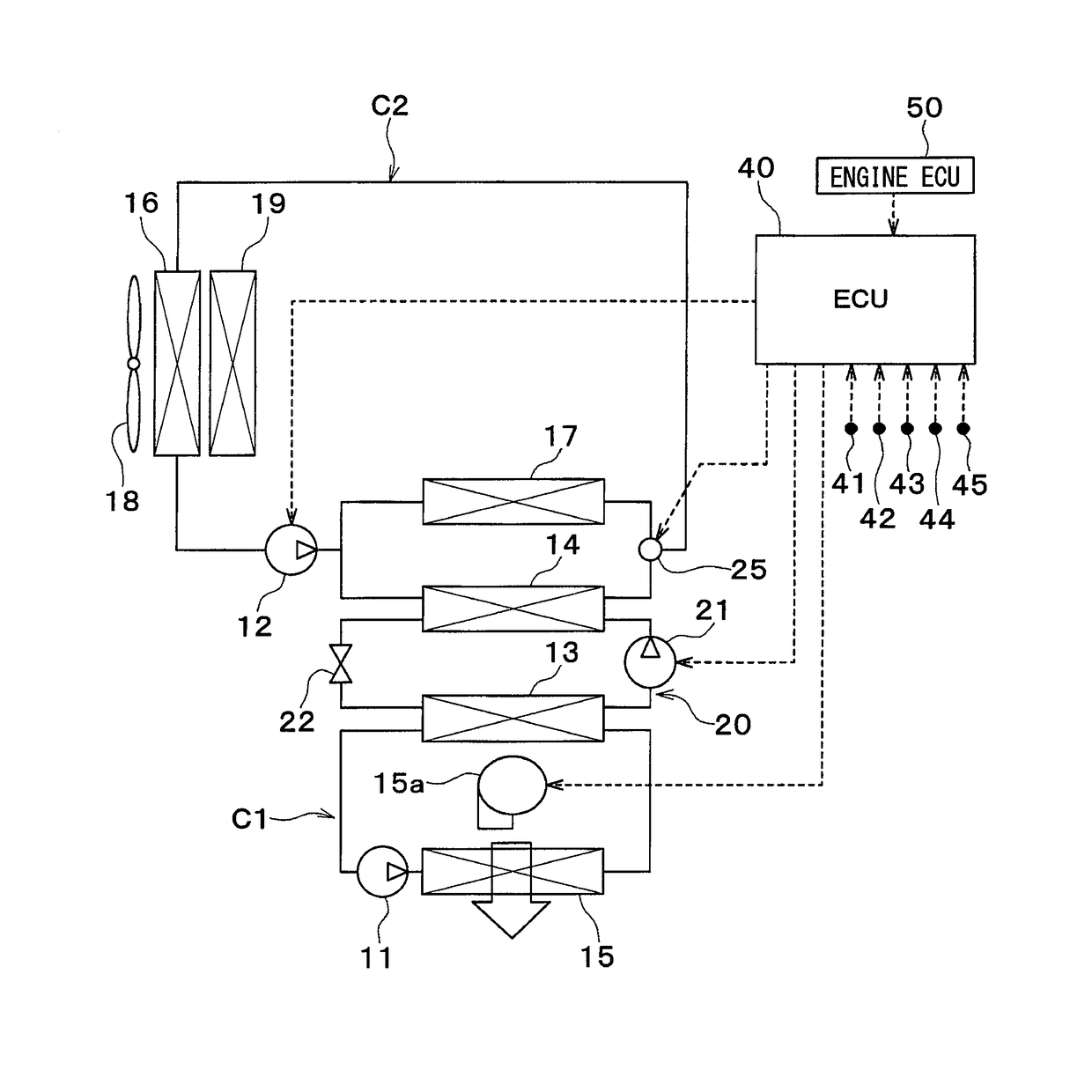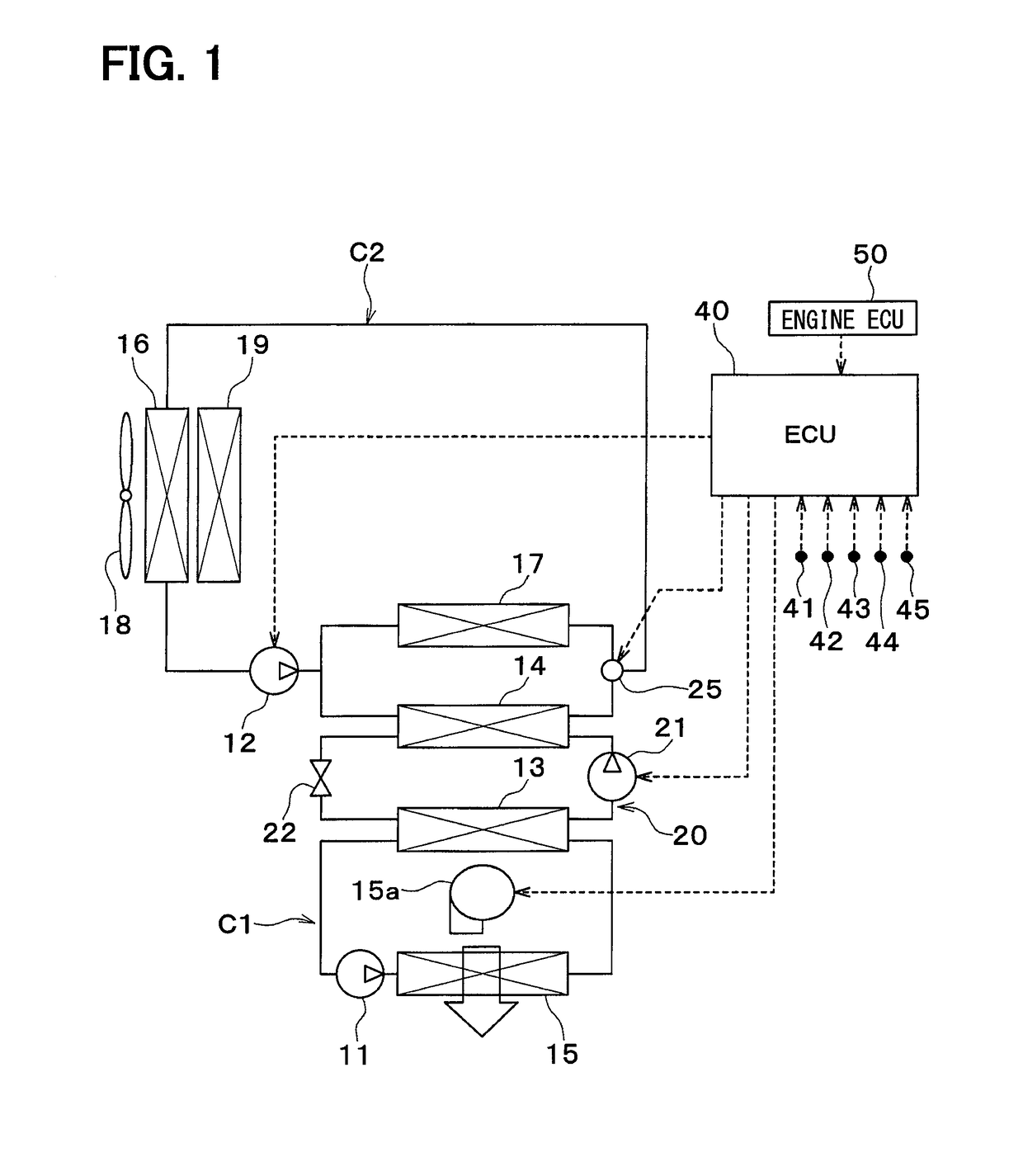Thermal management device
- Summary
- Abstract
- Description
- Claims
- Application Information
AI Technical Summary
Benefits of technology
Problems solved by technology
Method used
Image
Examples
first embodiment
[0024]A first embodiment will be described below based on FIGS. 1 to 3. A vehicle thermal management device shown in FIG. 1 is used to adjust various devices mounted on a vehicle or an interior of the vehicle to an appropriate temperature.
[0025]The vehicle thermal management device includes a first pump 11, a second pump 12, a chiller 13, a condenser 14, a cooler core 15, a radiator 16, and an intercooler 17.
[0026]Each of the first pump 11 and the second pump 12 is an electric pump that draws and discharges a coolant (heat medium). The coolant is a fluid as the heat medium. In the embodiment, the coolant suitable for use includes a liquid containing at least ethylene glycol, dimethylpolysiloxane, or a nanofluid, or an antifreezing solution.
[0027]The chiller 13, the condenser 14, the cooler core 15, the radiator 16, and the intercooler 17 are coolant circulation devices (heat-medium circulation devices) through which the coolant circulates.
[0028]The chiller 13 is a low-pressure side ...
second embodiment
[0096]In the embodiment, as shown in FIG. 4, the intake-air cooling priority control in step S111 is carried out as follows. (1) The operation of the three-way valve 25 is controlled to allow the coolant to flow through the intercooler 17 but not through the condenser 14. (2) The compressor 21 is stopped. (3) The cooler core 15 cools the air by using a cold storage function of the first coolant circuit C1. (4) The volume of air blown by the interior blower 15a is reduced.
[0097]Thus, the volume of air flowing through the cooler core 15 is reduced, thereby decreasing the temperature of the air cooled by the cooler core 15. Therefore, the cooling comfort in the vehicle interior can be further maintained.
[0098]In step S130, to reset the intake-air cooling priority control, the following control is carried out. (1) The operation of the three-way valve 25 is controlled to allow the coolant to flow through both the intercooler 17 and the condenser 14. (2) The compressor 21 is operated. (3)...
third embodiment
[0103]Although in the first embodiment, the three-way valve 25 adjusts the flow rate of the coolant flowing through the intercooler 17, in the embodiment, as shown in FIG. 5, a two-way valve 26 adjusts the flow rate of the coolant flowing through the intercooler 17.
[0104]The two-way valve 26 is disposed in a coolant flow path on the condenser 14 side, selected from the coolant flow paths (i.e., two coolant flow paths arranged in parallel) on the condenser 14 side and the intercooler 17 side. Thus, the two-way valve 26 adjusts the opening of the coolant flow path on the condenser 14 side. The two-way valve 26 is capable of opening and closing the coolant flow path on the condenser 14 side.
[0105]That is, the two-way valve 26 is a flow-rate ratio adjustment device that adjusts the ratio of the flow rate of the coolant flowing through the condenser 14 to that through the intercooler 17. In other words, the two-way valve 26 is a flow-rate adjustment device that adjusts the flow rate of t...
PUM
 Login to View More
Login to View More Abstract
Description
Claims
Application Information
 Login to View More
Login to View More - R&D
- Intellectual Property
- Life Sciences
- Materials
- Tech Scout
- Unparalleled Data Quality
- Higher Quality Content
- 60% Fewer Hallucinations
Browse by: Latest US Patents, China's latest patents, Technical Efficacy Thesaurus, Application Domain, Technology Topic, Popular Technical Reports.
© 2025 PatSnap. All rights reserved.Legal|Privacy policy|Modern Slavery Act Transparency Statement|Sitemap|About US| Contact US: help@patsnap.com



